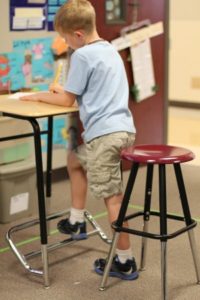Physical activity, even acute and less intense levels, has beneficial effects on cognitive ability. We know that standing while working has increased health benefits for adults. Now researchers have found that children who stand at their desks in the classroom are more engaged and attentive than their seated peers.
In the study, researchers at Texas A&M Health Science Center School of Public Health found that elementary students who used standing desks performed higher on measures of engagement during class.
The researchers were originally interested in studying the effects of standing-desks on children’s health and stress similar to the effects found for adults. However, they quickly learned that standing while learning offered benefits beyond reducing obesity and lowering levels of stress in children.
Think On Your Feet
 Take a StandIn the study, the researchers examined nearly 300 students in 2nd, 3rd, and 4th grade over the course of one school year. The researchers compared students who stood at their desks for the majority of the day to students who remained seated. Researchers measured children's engagement with on-task behaviors such as answering questions in class, raising their hands, participating in class discussions. Researchers also measured children's off-task behaviors which included talking out of turn or not paying attention. [Photo Courtesy of Stand2Learn]
Take a StandIn the study, the researchers examined nearly 300 students in 2nd, 3rd, and 4th grade over the course of one school year. The researchers compared students who stood at their desks for the majority of the day to students who remained seated. Researchers measured children's engagement with on-task behaviors such as answering questions in class, raising their hands, participating in class discussions. Researchers also measured children's off-task behaviors which included talking out of turn or not paying attention. [Photo Courtesy of Stand2Learn]
Researchers indeed found that children’s engagement, attention, and academic achievement improved after a year of standing in class. Standing work stations are correlated with less disruptive behavior in children as well. The researchers suggest that standing during the day breaks up the monotony of sitting and allows children more freedom to move around.
Furthermore, the results suggest that school districts may be able to combat childhood obesity and increase academic achievement with standing desks in classrooms. Standing desks may also be a way for shrinking school budgets to increase acute forms of physical activity in a cost effective manner.
Physical activity is vital to children’s physical and mental health...schools should ‘jump’ at the chance to decrease sedentary behavior!
StepUp combines movement, rhythm, and repetition with curriculum. As children progress through the program levels, they develop fluency in reading decoding, handwriting, and math fact retrieval.
Watch this video to see StepUp to Learn in action!
 P.S. If you liked this post, why not get our Learning in Motion email?
P.S. If you liked this post, why not get our Learning in Motion email?
Awesome, research-based ideas for learning enrichment. Get on the list.
